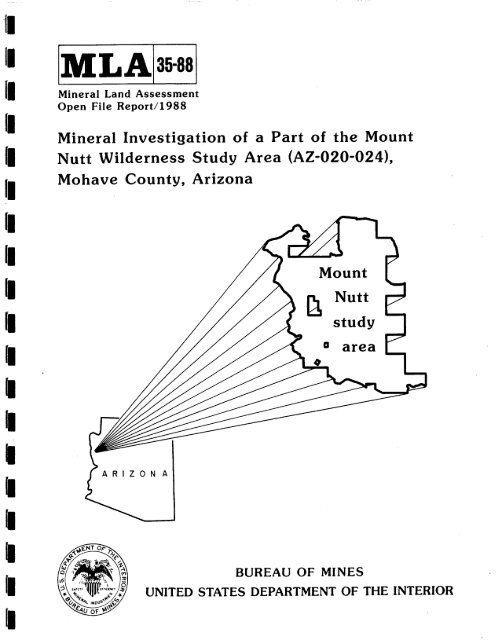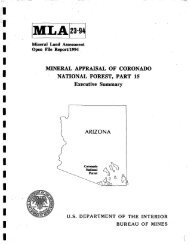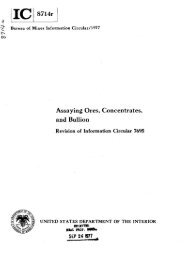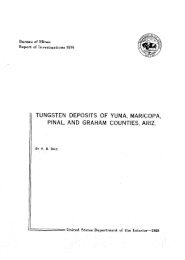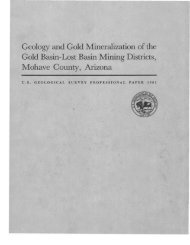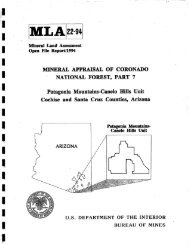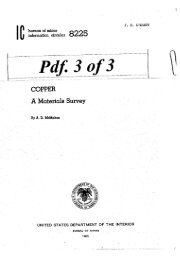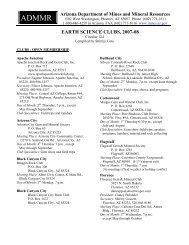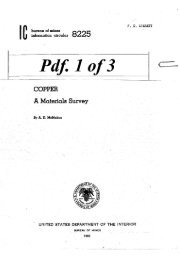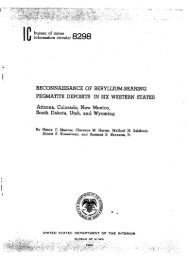MLA 35-88 - State of Arizona Department of Mines and Mineral ...
MLA 35-88 - State of Arizona Department of Mines and Mineral ...
MLA 35-88 - State of Arizona Department of Mines and Mineral ...
Create successful ePaper yourself
Turn your PDF publications into a flip-book with our unique Google optimized e-Paper software.
ii<br />
a<br />
!<br />
!11<br />
Ill<br />
<strong>Mineral</strong> L<strong>and</strong> Assessment<br />
Open File Report/19<strong>88</strong><br />
<strong>Mineral</strong> Investigation <strong>of</strong> a Part <strong>of</strong> the Mount<br />
Nutt Wilderness Study Area (AZo020-024),<br />
Mohave County, <strong>Arizona</strong><br />
Mount<br />
[~ Nutt<br />
study<br />
a<br />
@<br />
area<br />
ARIZON<br />
A<br />
III<br />
III<br />
!11<br />
/<br />
~ Y<br />
BUREAU OF MINES<br />
UNITED STATES DEPARTMENT OF THE INTERIOR
I<br />
I<br />
I<br />
I<br />
I<br />
I<br />
I<br />
I<br />
I<br />
I<br />
I<br />
I<br />
I<br />
I<br />
I<br />
I<br />
MINERAL INVESTIGATION OF A PART OF THE MOUNT NUTT WILDERNESS STUDY<br />
AREA (AZ-020-024), MOHAVE COUNTY, ARIZONA<br />
by<br />
Carl L. Almquist<br />
<strong>MLA</strong> <strong>35</strong>-<strong>88</strong><br />
19<strong>88</strong><br />
Intermountain Field Operations Center<br />
Denver, Colorado<br />
UNITED STATES DEPARTMENT OF THE INTERIOR<br />
Donald P. Hodel, Secretary<br />
BUREAU OF MINES<br />
T S Ary, Director<br />
........ & 1<br />
• ~C ~.S
I<br />
I<br />
i<br />
I<br />
I<br />
I<br />
I<br />
I<br />
I<br />
I<br />
I<br />
I<br />
I<br />
I<br />
I<br />
I<br />
PREFACE<br />
The Federal L<strong>and</strong> Policy <strong>and</strong> Management Act <strong>of</strong> 1976 (Public Law 94-59)<br />
requires the U.S. Geological Survey <strong>and</strong> the U.S. Bureau <strong>of</strong> <strong>Mines</strong> to conduct<br />
mineral surveys on certain areas to determine the mineral values, if any, that<br />
may be present. Results must be made available to the public <strong>and</strong> be submitted<br />
to the President <strong>and</strong> the Congress. This report presents the results <strong>of</strong> a<br />
mineral survey <strong>of</strong> a part <strong>of</strong> the Mount Nutt Wilderness Study Area (AZ-020-024),<br />
Mohave County, <strong>Arizona</strong>.<br />
This open-file report summarizes the results <strong>of</strong> a<br />
Bureau <strong>of</strong> <strong>Mines</strong> wilderness study. The report is<br />
preliminary <strong>and</strong> has not been edited or reviewed<br />
for conformity with the Bureau <strong>of</strong> <strong>Mines</strong> editorial<br />
st<strong>and</strong>ards. This study was conducted by personnel<br />
from the Branch <strong>of</strong> Resource Evaluation,<br />
Intermountain Field Operations Center, P. O. Box<br />
25086, Denver Federal Center, Denver, CO B0225.


